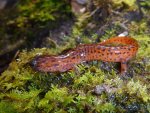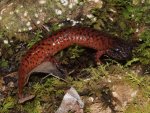Lamb
New member
- Joined
- Feb 28, 2009
- Messages
- 222
- Reaction score
- 12
- Points
- 0
- Age
- 35
- Location
- USA
- Country
- United States
Hello all,
I wanted to share the latest luck that I've had in the field. I'm taking my university's herpetology class on day trips to search for plethodontid salamanders, so myself and a tech have been out and about looking for salamander "honey holes" in South Mississippi. My goal is to find good Desmognathus spots within a "short" drive from campus, but finding good Pseudotriton localities would be great as well (I'm studying both genera for my dissertation work, and have a particular interest in the latter because it is much less common [or encountered] in MS).
We've had some great days in the coastal counties of MS with both genera. I've attached photos of two of the P. ruber that we found. The younger individual in the photos was encountered in the uppermost portion of a seep-fed stream. We found it beneath a log in the middle of a large, soggy patch of earth. The older individual pictured (less brightly colored) was found in a different seep-fed stream, on a separate trip, beneath a large, uplifted root that was draped in thick moss.
I wanted to ask if older individuals elsewhere in the range looked as dull as the one in this photograph? From the vague recesses of my mind, I think I remember that the purplish color is a trait exhibited by older individuals of the subspecies we have in this area. Also, this adult, along with another large and similarly colored adult which I found in a nearby seep, was rather skinny. Or at least that's how it appeared to me (but I haven't caught many transformed individuals of this species). Many of the field herping photos I see of Pseudotriton show bright, plump individuals. Anyone else out there have photos of older Pseudotriton?
I wanted to share the latest luck that I've had in the field. I'm taking my university's herpetology class on day trips to search for plethodontid salamanders, so myself and a tech have been out and about looking for salamander "honey holes" in South Mississippi. My goal is to find good Desmognathus spots within a "short" drive from campus, but finding good Pseudotriton localities would be great as well (I'm studying both genera for my dissertation work, and have a particular interest in the latter because it is much less common [or encountered] in MS).
We've had some great days in the coastal counties of MS with both genera. I've attached photos of two of the P. ruber that we found. The younger individual in the photos was encountered in the uppermost portion of a seep-fed stream. We found it beneath a log in the middle of a large, soggy patch of earth. The older individual pictured (less brightly colored) was found in a different seep-fed stream, on a separate trip, beneath a large, uplifted root that was draped in thick moss.
I wanted to ask if older individuals elsewhere in the range looked as dull as the one in this photograph? From the vague recesses of my mind, I think I remember that the purplish color is a trait exhibited by older individuals of the subspecies we have in this area. Also, this adult, along with another large and similarly colored adult which I found in a nearby seep, was rather skinny. Or at least that's how it appeared to me (but I haven't caught many transformed individuals of this species). Many of the field herping photos I see of Pseudotriton show bright, plump individuals. Anyone else out there have photos of older Pseudotriton?





